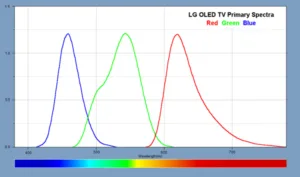 Dr. Ray Soneira of DisplayMate Technologies has performed a test of one of the latest 2017 LG OLED TV range, the Model 65E7 and has praised it as ‘visually indistinguishable from perfect’ and could even qualify as a professional reference studio monitor.
Dr. Ray Soneira of DisplayMate Technologies has performed a test of one of the latest 2017 LG OLED TV range, the Model 65E7 and has praised it as ‘visually indistinguishable from perfect’ and could even qualify as a professional reference studio monitor.
A major improvement in this year’s models is that the display and Soneira said that
“it maintains its picture brightness and luminance virtually independent of the Average Picture Level (APL), with only a 3% decrease at 25% APL, and just a 5% decrease at 90% APL, which is an almost all white screen, so it also performs really well when viewing PC and web text content that often has APLs of 50% or more. For comparison: OLED Smartphones have a typical decrease of 25% luminance at 50% APL, and the 2016 LG OLED TV a 35% decrease at 50% APL.”
This result was achieved when the TV was set to Cinema mode (DCI-P3 or Rec 709 modes), when the peak brightness is 280 cd/m². When the brightness is boosted in the Vivid mode, then the peak brightness rises to 460 cd/m², but falls to 217 cd/m² at 90% brightness, a drop of 53% in SDR modes. In HDR mode, the peak brightness goes up to around 750 cd/m² while the colour gamut is over 100% of DCI-P3.
The TV achieves a record for several factors that the company measured:
- Highest absolute color accuracy (0.7 JNCD)
- Highest absolute luminance accuracy (±3%)
- Highest contrast ratio with ‘perfect’ black levels
There are other superlatives and almost every measurement was improved compared to 2016, including the highest peak brightness.
Screen reflections (which have sometimes been a cause of criticism of OLEDs) were measured as 1.2% (average) and 2.1% for specular reflections, which DisplayMate rates as ‘Excellent’. In high ambient light conditions, the contrast rating is 375:1 in vivid mode and drops to 227 in cinema modes.
OLEDs are noted for better performance at wider viewing angles than LCDs and DisplayMate found that there was a 24% brightness drop at 45º in all modes, with a colour shift of 3.4 JNCD, which the firm rates as ‘Very Good’. The intensity scale is maintained at wider angle viewing and colour gamuts actually get wider, which is from the blue primary.
Analyst Comment
The general tone of Ray’s article is unsurprising, given that it was very positive last year and this year’s set is better.

